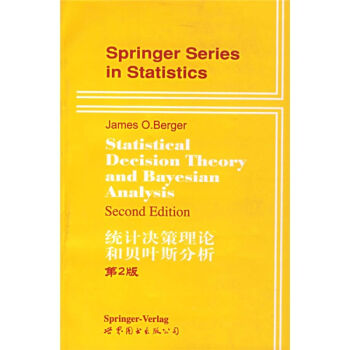

具體描述
內容簡介
The relationships (both conceptual and mathematical) between Bayesian analysis and statistical decision theory are so strong that it is somewhat unnatural to learn one without the other. Nevertheless, major portions of each have developed separately. On the Bayesian side, there is an extensively developed Bayesian theory of statistical inference (both subjective and objective versions). This theory recognizes the importance of viewing statistical analysis conditionally (i.e., treating observed data as known rather than unknown), even when no loss function is to be incorporated into the analysis. There is also a well-developed (frequentist) decision theory, which avoids formal utilization of prior distributions and seeks to provide a foundation for frequentist statistical theory. Although the central thread of the book will be Bayesian decision theory, both Bayesian inference and non-Bayesian decision theory will be extensively discussed. Indeed, the book is written so as to allow, say, the teaching of a course on either subject separately.目錄
CHAPTER 1Basic Concepts
1.1 Introduction
1.2 Basic Elements
1.3 Expected Loss, Decision Rules, and Risk
1.3.1 Bayesian Expected Loss
1.3.2 Frequentist Risk
1.4 Randomized Decision Rules
1.5 Decision Principles
1.5.1 The Conditional Bayes Decision Principle
1.5.2 Frequentist Decision Principles
1.6 Foundations
1.6.1 Misuse of Classical Inference Procedures
1.6.2 The Frequentist Perspective
1.6.3 The Conditional Perspective
1.6.4 The Likelihood Principle
1.6.5 Choosing a Paradigm or Decision Principle
1.7 Sufficient Statistics
1.8 Convexity
Exercises
CHAPTER 2 Utility and Loss
2.1 Introduction
2.2 Utility Theory
2.3 The Utility of Money
2.4 The Loss Function
2.4.1 Development from Utility Theory
2.4.2 Certain Standard Loss Functions
2.4.3 For Inference Problems
2.4.4 For Predictive Problems
2.4.5 Vector Valued Loss Functions
2.5 Criticisms
Exercises
CHAPTER 3 Prior Information and Subjective Probability
3.1 Subjective Probability
3.2 Subjective Determination of the Prior Density
3.3 Noninformative Priors
3.3.1 Introduction
3.3.2 Noninformative Priors for Location and Scale Problems
3.3.3 Noninformative Priors in General Settings
3.3.4 Discussion
3.4 Maximum Entropy Priors
3.5 Using the Marginal Distribution to Determine the Prior
3.5.1 The Marginal Distribution
3.5.2 Information About tn
3.5.3 Restricted Classes of Priors
3.5.4 The ML-II Approach to Prior Selection
3.5.5 The Moment Approach to Prior Selection
3.5.6 The Distance Approach to Prior Selection
3.5.7 Marginal Exchangeability
3.6 Hierarchical Priors
3.7 Criticisms
3.8 The Statisticians Role
Exercises
CHAPTER 4 Bayesian Analysis
4.1 Introduction
4.2 The Posterior Distribution
4.2.1 Definition and Determination
4.2.2 Conjugate Families
4.2.3 Improper Priors
4.3 Bayesian Inference
4.3.1 Estimation
4.3.2 Credible Sets
4.3.3 Hypothesis Testing
4.3.4 Predictive Inference
4.4 Bayesian Decision Theory
4.4.1 Posterior Decision Analysis
4.4.2 Estimation
4.4.3 Finite Action Problems and Hypothesis Testing
4.4.4 With Inference Losses
4.5 Empirical Bayes Analysis
4.5.1 Introduction
4.5.2 PEB For Normal Means--The Exchangeable Case
4.5.3 PEB For Normal Means--The General Case
4.5.4 Nonparametric Empirical Bayes Analysis
4.6 Hierarchical Bayes Analysis
4.6.1 Introduction
4.6.2 For Normal Means--The Exchangeable Case
4.6.3 For Normal Means--The General Case
4.6.4 Comparison with Empirical Bayes Analysis
4.7 Bayesian Robustness
4.7.1 Introduction
4.7.2 The Role of the Marginal Distribution
4.7.3 Posterior Robustness: Basic Concepts
4.7.4 Posterior Robustness: s-Contamination Class
4.7.5 Bayes Risk Robustness and Use of Frequentist Measures
4.7.6 Gamma-Minimax Approach
4.7.7 Uses of the Risk Function
4.7.8 Some Robust and Nonrobust Situations
4.7.9 Robust Priors
4.7.10 Robust Priors for Normal Means
4.7.11 Other Issues in Robustness
4.8 Admissibility of Bayes Rules and Long Run Evaluations
4.8.1 Admissibility of Bayes Rules
4.8.2 Admissibility of Generalized Bayes Rules
4.8.3 Inadmissibility and Long Run Evaluations
4.9 Bayesian Calculation
4.9.1 Numerical Integration
4.9.2 Monte Carlo Integration
4.9.3 Analytic Approximations
4.10 Bayesian Communication
4.10.1 Introduction
4.10.2 An Illustration: Testing a Point Null Hypothesis
4.11 Combining Evidence and Group Decisions
4.11.1 Combining Probabilistic Evidence
4.11.2 Combining Decision-Theoretic Evidence
4.11.3 Group Decision Making
4.12 Criticisms
4.12.1 Non-Bayesian Criticisms
4.12.2 Foundational Criticisms
Exercises
CHAPTER 5 Minimax Analysis
5.1 Introduction
5.2 Game Theory
5.2.1 Basic Elements
5.2.2 General Techniques for Solving Games
5.2.3 Finite Games
5.2.4 Games with Finite
5.2.5 The Supporting and Separating Hyperplane Theorems
5.2.6 The Minimax Theorem
5.3 Statistical Games
5.3.1 Introduction
5.3.2 General Techniques for Solving Statistical Games
5.3.3 Statistical Games with Finite
5.4 Classes of Minimax Estimators
5.4.1 Introduction
5.4.2 The Unbiased Estimator of Risk
5.4.3 Minimax Estimators of a Normal Mean Vector
5.4.4 Minimax Estimators of Poisson Means
5.5 Evaluation of the Minimax Principle
5.5.1 Admissibility of Minimax Rules
5.5.2 Rationality and the Minimax Principle
5.5.3 Comparison with the Bayesian Approach
5.5.4 The Desire to Act Conservatively
5.5.5 Minimax Regret
5.5.6 Conclusions
Exercises
CHAPTER 6 Invariance
6.1 Introduction
6.2 Formulation
6.2.1 Groups of Transformations
6.2.2 Invariant Decision Problems
6.2.3 Invariant Decision Rules
6.3 Location Parameter Problems
6.4 Other Examples of Invariance
6.5 Maximal lnvariants
6.6 Invariance and Noninformative Priors
6.6.1 Right and Left Invariant Haar Densities
6.6.2 The Best Invariant Rule
6.6.3 Confidence and Credible Sets
6.7 Invariance and Minimaxity
6.8 Admissibility of Invariant Rules
6.9 Conclusions
Exercises
CHAPTER 7 Preposterior and Sequential Analysis
7.1 Introduction
7.2 Optimal Fixed Sample Size
7.3 Sequential Analysis--Notation
7.4 Bayesian Sequential Analysis
7.4.1 Introduction
7.4.2 Notation
7.4.3 The Bayes Decision Rule
7.4.4 Constant Posterior Bayes Risk
7.4.5 The Bayes Truncated Procedure
7.4.6 Look Ahead Procedures
7.4.7 Inner Truncation
7.4.8 Approximating the Bayes Procedure and the Bayes Risk
7.4.9 Theoretical Results
7.4.10 Other Techniques for Finding a Bayes Procedure
7.5 The Sequential Probability Ratio Test
7.5.1 The SPRT as a Bayes Procedure
7.5.2 Approximating the Power Function and the Expected Sample Size
7.5.3 Accuracy of the Wald Approximations
7.5.4 Bayes Risk and Admissibility
7.5.5 Other Uses of the SPRT
7.6 Minimax Sequential Procedures
7.7 The Evidential Relevance of the Stopping Rule
7.7.1 Introduction
7.7.2 The Stopping Rule Principle
7.7.3 Practical Implications
7.7.4 Criticisms of the Stopping Rule Principle
7.7.5 Informative Stopping Rules
7.8 Discussion of Sequential Loss Functions
Exercises
CHAPTER 8 Complete and Essentially Complete Classes
8.1 Preliminaries
8.2 Complete and Essentially Complete Classes from Earlier Chapters
8.2.1 Decision Rules Based on a Sufficient Statistic
8.2.2 Nonrandomized Decision Rules
8.2.3 Finite O
8.2.4 The Neyman-Pearson Lemma
8.3 One-Sided Testing
8.4 Monotone Decision Problems
8.4.1 Monotone Multiple Decision Problems
8.4.2 Monotone Estimation Problems
8.5 Limits of Bayes Rules
8.6 Other Complete and Essentially Complete Classes of Tests
8.6.1 Two-Sided Testing
8.6.2 Higher Dimensional Results
8.6.3 Sequential Testing
8.7 Complete and Essentially Complete Classes in Estimation
8.7.1 Generalized Bayes Estimators
8.7.2 Identifying Generalized Bayes Estimators
8.8 Continuous Risk Functions
8.9 Proving Admissibility and Inadmissibility
8.9.1 Steins Necessary and Sufficient Condition for Admissibility
8.9.2 Proving Admissibility
8.9.3 Proving Inadmissibility
8.9.4 Minimal or Nearly Minimal Complete Classes
Exercises
APPENDIX 1 Common Statistical Densities
I Continuous
II Discrete
APPENDIX 2 Supplement to Chapter 4
I Definition and Properties of Hm
II Development of (4.121) and (4.122)
III Verification of Formula (4.123)
APPENDIX 3 Technical Arguments from Chapter 7
I Verification of Formula (7.8)
II Verification of Formula (7.10)
Bibliography
Notation and Abbreviations
Author Index
Subject Index
前言/序言
用戶評價
評分這本書就像是一位循循善誘的導師,引導我一步步穿越統計決策理論的迷宮。我特彆喜歡作者對於“無知”的處理方式,在信息不完全或者不確定性很高的情況下,如何通過引入先驗分布來彌閤知識的鴻溝。書中關於“信息價值”的討論也讓我受益匪淺,它讓我們思考,為瞭獲得某個決策所需的額外信息,我們願意付齣多少代價,以及如何設計有效的實驗來獲取這些信息。在貝葉斯分析的部分,作者巧妙地將復雜的概率推理過程分解為易於理解的步驟,讓我能夠清晰地把握每一步的邏輯。例如,在處理序列數據時,書中對馬爾可夫鏈的介紹,以及如何利用它來構建預測模型,都給我留下瞭深刻的印象。讀完這本書,我感覺自己不僅是在學習一門學科,更是在培養一種看待問題的方式——一種更加審慎、更加數據導嚮、也更加能夠擁抱不確定性的思維模式。它讓我明白,在信息不完整的世界裏,我們並非束手無策,而是可以通過科學的方法來做齣更好的決策。
評分我之所以對這本書情有獨鍾,是因為它在理論的深度和應用的廣度之間找到瞭完美的平衡點。在統計決策理論方麵,本書係統地梳理瞭從基礎概念到高級模型的演進脈絡,讓我能夠清晰地認識到不同決策框架的優勢與局限。特彆是在處理現實世界中的復雜決策時,書中提供的多種工具和方法,如動態規劃、博弈論等,都具有極強的實踐指導意義。而貝葉斯分析的章節,更是讓我體會到瞭其在數據挖掘和機器學習領域的強大威力。書中對貝葉斯網絡的講解,以及如何利用它進行因果推斷和預測,是我之前學習中從未見過如此清晰和係統的闡述。我發現,這本書不僅僅是知識的羅列,更重要的是它能夠激發讀者的思考,鼓勵讀者去探索和創新。每一次閱讀,我都能從中獲得新的啓發,不斷刷新我對統計決策和貝葉斯分析的理解。這本書無疑是我學習道路上的一座重要裏程碑。
評分這本書的書名讓我一度望而卻步,"統計決策理論"聽起來就充滿瞭數學和邏輯的嚴謹,而"貝葉斯分析"更是讓人聯想到復雜的概率模型和迭代計算。然而,一旦翻開,我便被其深度和廣度所吸引。作者並沒有止步於理論的陳述,而是通過大量精心設計的案例,將抽象的概念具象化。從最初的簡單決策問題,到後麵涉及多階段決策、不確定性下的策略選擇,每一個章節都像是在搭建一座精密的模型,引導讀者一步步深入理解如何量化風險,如何權衡收益。我尤其欣賞其中關於先驗信息的處理方式,它不僅僅是數學公式的堆砌,更是對決策者主觀判斷和客觀數據的巧妙融閤,讓人體會到貝葉斯方法在信息更新和信念調整上的強大力量。即使是對於一些我之前認為非常棘手的概念,例如馬爾可夫決策過程,書中也提供瞭清晰的解釋和直觀的類比,讓我在閱讀過程中感受到思維的豁然開朗。這本書的價值遠不止於理論學習,它更像是一把鑰匙,開啓瞭我用更係統、更理性的方式去審視和解決現實世界中復雜問題的視野。
評分初次接觸這本書,我最直觀的感受是其內容的“硬核”。它毫不避諱地深入探討瞭統計決策理論的核心概念,比如損失函數、效用函數、風險函數等,這些都是構建決策模型的基礎。作者的寫作風格非常務實,強調的是如何將這些理論應用於實際問題。在我看來,這本書最齣彩的地方在於它對貝葉斯分析的講解。不同於許多教科書僅僅羅列公式,本書詳細闡述瞭貝葉斯定理的直觀意義,以及如何通過似然函數和先驗分布來更新後驗分布,從而做齣更優的決策。特彆是對於一些經典的貝葉斯模型,如綫性迴歸中的貝葉斯方法,或是分類問題中的貝葉斯判彆分析,書中都給齣瞭詳盡的推導和實例演示。我發現,通過這本書的學習,我不僅掌握瞭理論知識,更重要的是,我學會瞭如何將這些理論轉化為解決實際問題的工具。它教會瞭我如何根據問題的特性選擇閤適的模型,如何理解模型的假設,以及如何評估模型的優劣。這本書對於任何希望在量化決策和數據驅動分析領域深入研究的讀者來說,都是一份寶貴的財富。
評分這本書的閱讀體驗是充滿挑戰與驚喜的結閤。在深入研究統計決策理論的某些章節時,我曾感到過一絲迷茫,特彆是當麵對一些復雜的優化問題時。然而,正是這種挑戰,促使我去更深入地思考和理解。書中對不同類型損失函數的討論,以及它們如何影響決策結果,是我之前很少深入接觸的。而貝葉斯分析的部分,則是我感到驚喜連連的地方。作者在解釋貝葉斯定理的演進過程時,用非常形象的比喻,讓我能夠直觀地理解“先驗”和“後驗”的概念。特彆是在處理“模型選擇”這一關鍵問題時,書中提供瞭多種貝葉斯視角下的方法,如模型平均等,這為我打開瞭新的思路。我發現,這本書不僅僅是提供知識,更重要的是教會我如何思考,如何從不同的角度審視問題。即使是對於一些看似簡單的決策,這本書也能引導我去挖掘其背後更深層次的統計原理。它是一本需要投入時間和精力去研讀的書,但每一次的深入,都會帶來意想不到的收獲。
因為是影映版,所以字母沒有特彆真。內容是比較經典的,還不錯吧。
評分是一本貝葉斯網絡的論文集,分建模、推理、應用三個部分,圖書館藉來復印瞭一本,講的內容跟生物和醫學方麵的比較緊密,如果你是搞這方麵的論文,這本書會有很好的幫助。
評分茆詩鬆 《貝葉斯統計》
評分神書,能夠看懂,深入淺齣
評分全新塑封的。還沒打開看。希望沒有缺頁少頁。
評分貝葉斯估計在很多地方都是需要用到的,學習學習
評分Bayesian network technologies(貝葉斯網絡技術:應用與圖形模型)
評分影印版。內容很不錯,參考價值極大。
評分挺好用的,京東的東西很不錯,送貨也很快
相關圖書
本站所有内容均为互联网搜索引擎提供的公开搜索信息,本站不存储任何数据与内容,任何内容与数据均与本站无关,如有需要请联系相关搜索引擎包括但不限于百度,google,bing,sogou 等
© 2025 book.tinynews.org All Rights Reserved. 静思书屋 版权所有









![高等量子力學 [Advanced Quantum Mechanics] pdf epub mobi 電子書 下載](https://pic.tinynews.org/10096466/c12ae560-d351-419d-8f1e-35ed17efa5e6.jpg)


![流形拓撲導論講義(英文版) [Introductory Lectures on Manifold Topology:Signposts] pdf epub mobi 電子書 下載](https://pic.tinynews.org/11434975/565d1577N756cb831.jpg)

![環境空氣PM2.5監測、預報與公眾信息服務 [Ambient PM2.5 MOnitoring,Forecasting, and Public Information Service] pdf epub mobi 電子書 下載](https://pic.tinynews.org/11898830/57079e18N9199f7f7.jpg)




![第二代測序信息處理 [Next-generation DNA sequencing informatics] pdf epub mobi 電子書 下載](https://pic.tinynews.org/11678643/554205ccN857d36a2.jpg)
